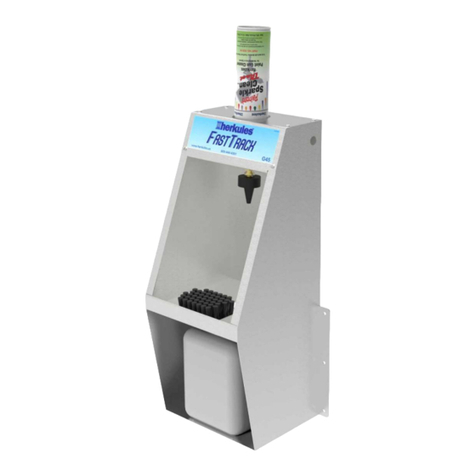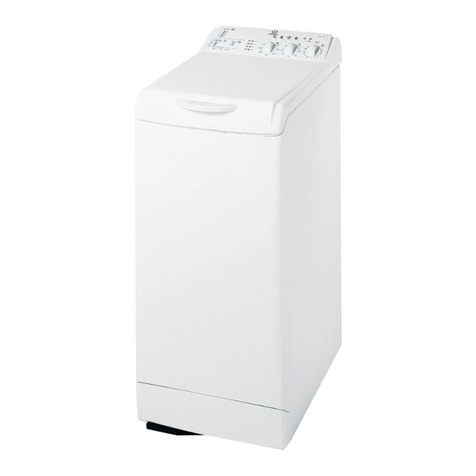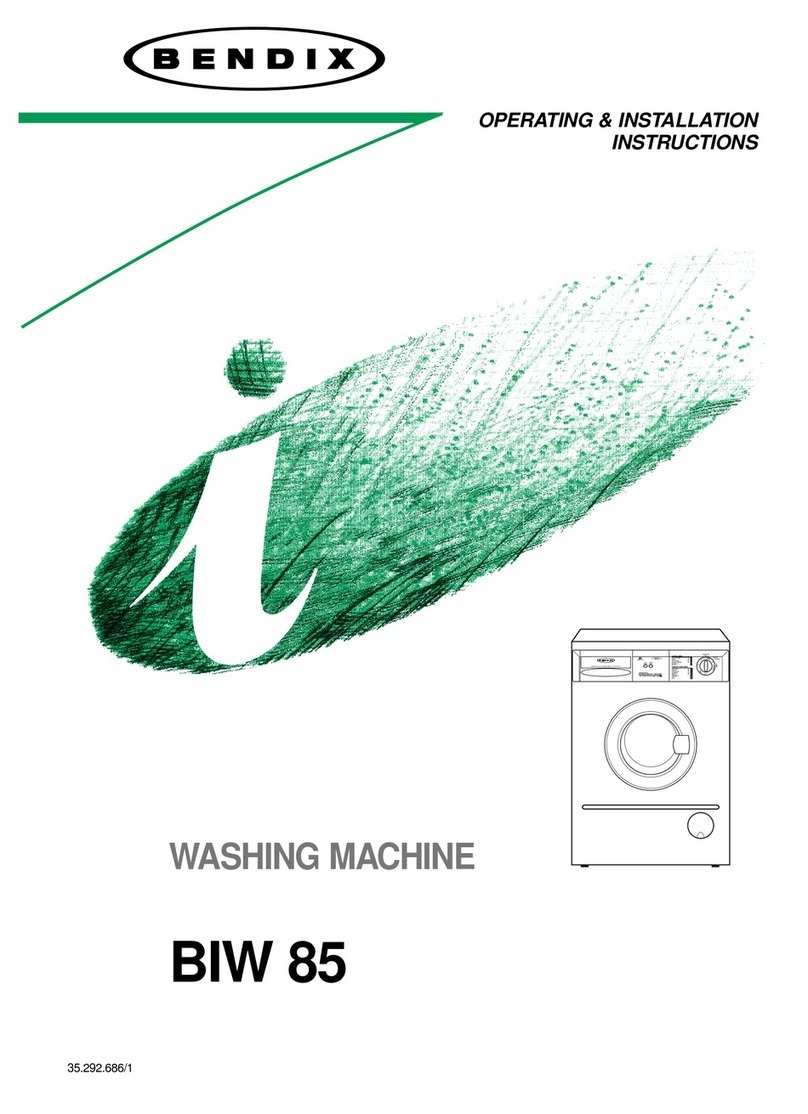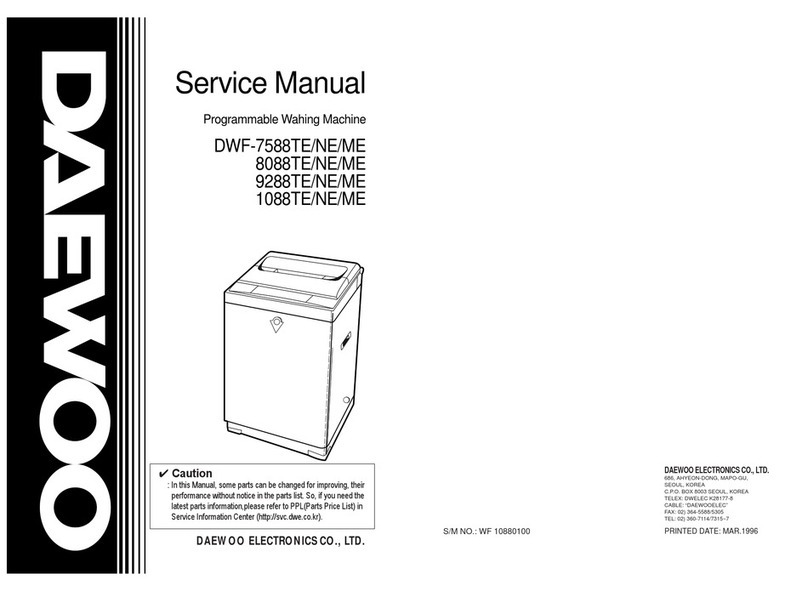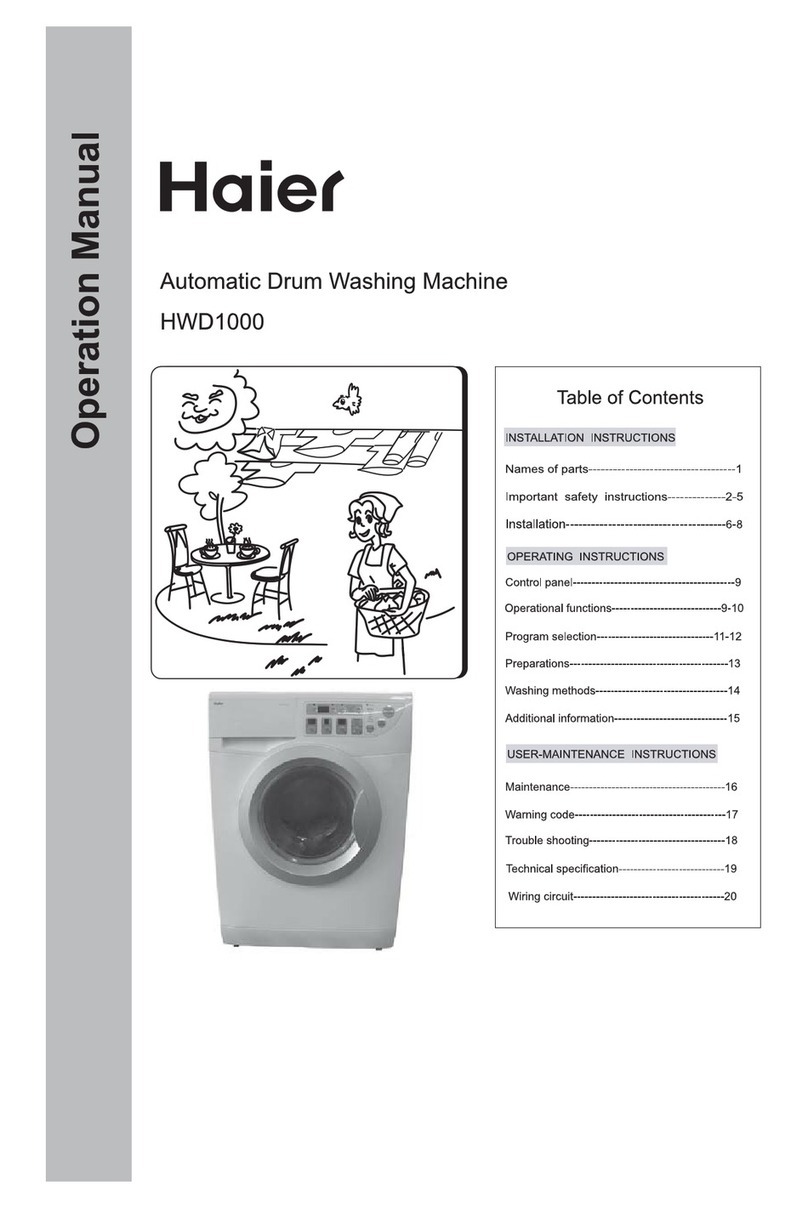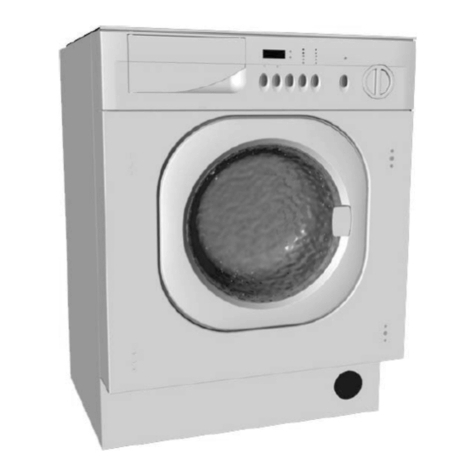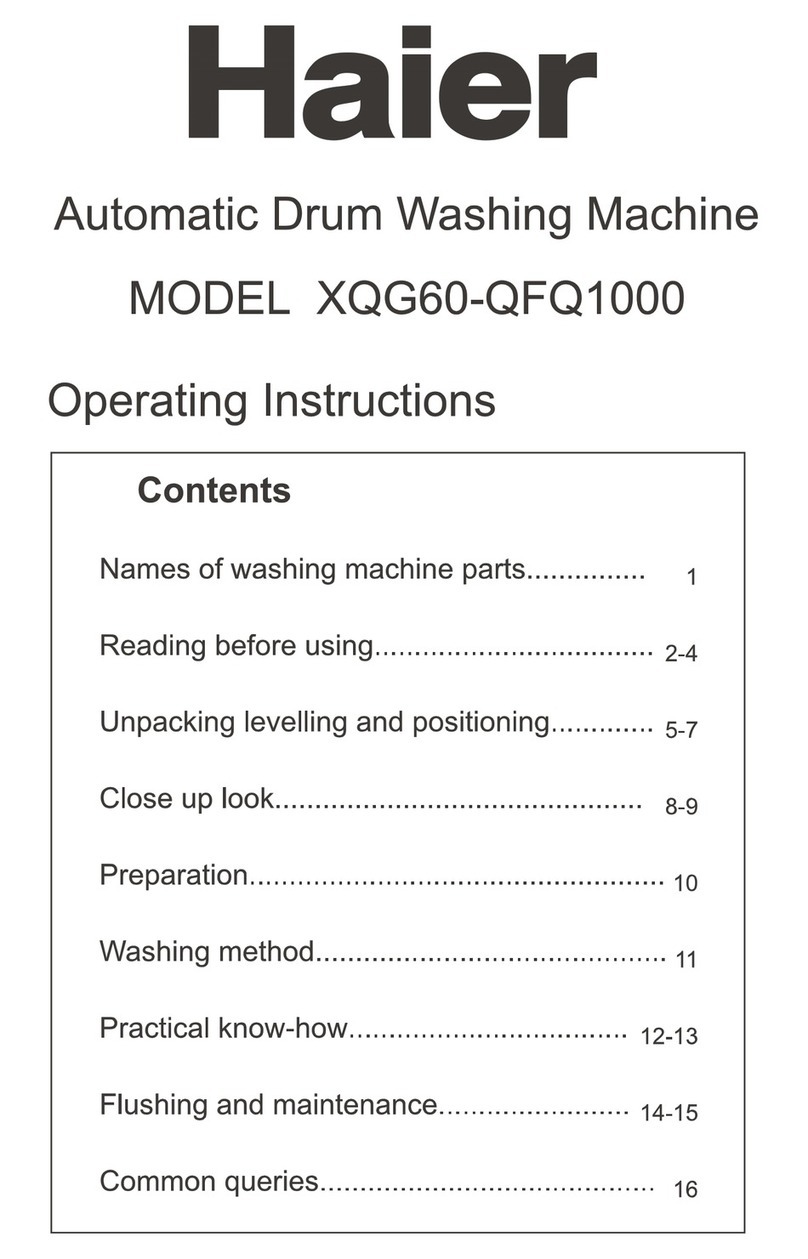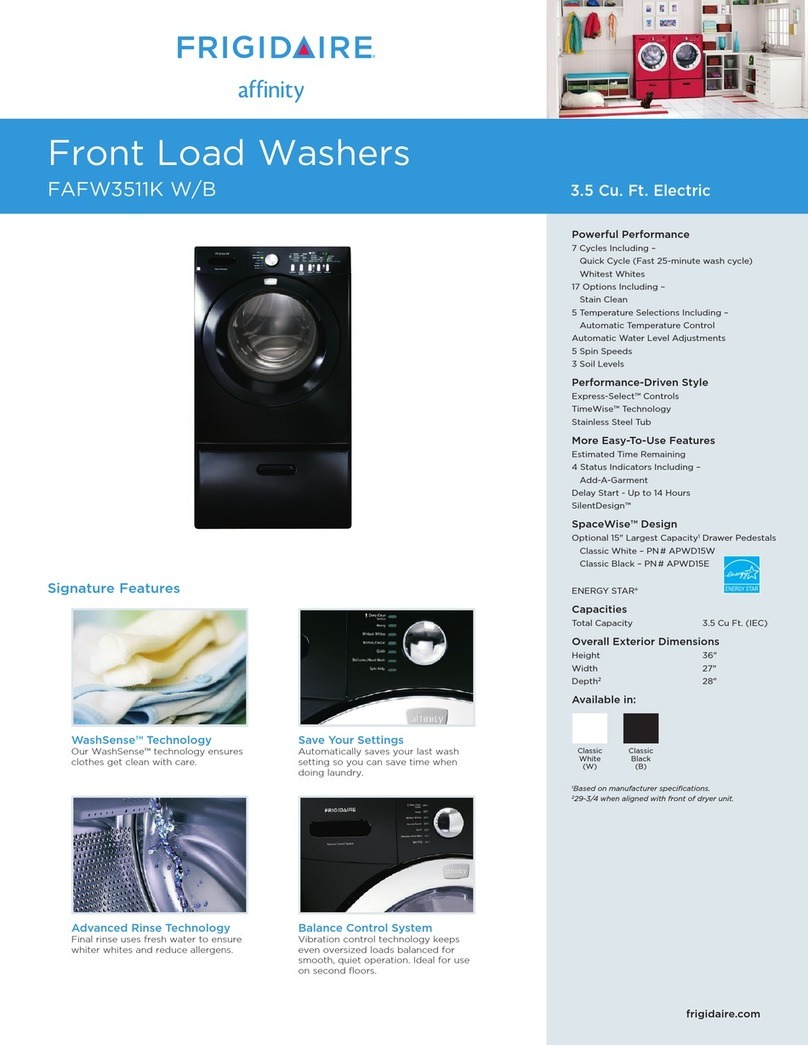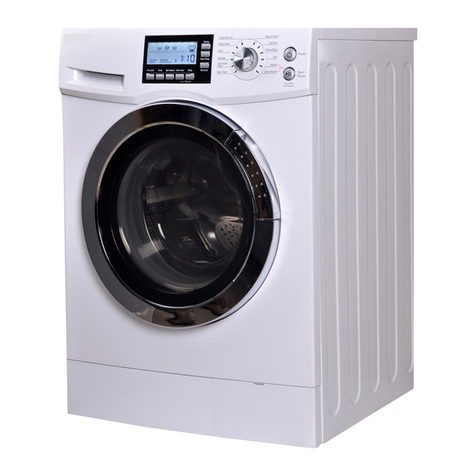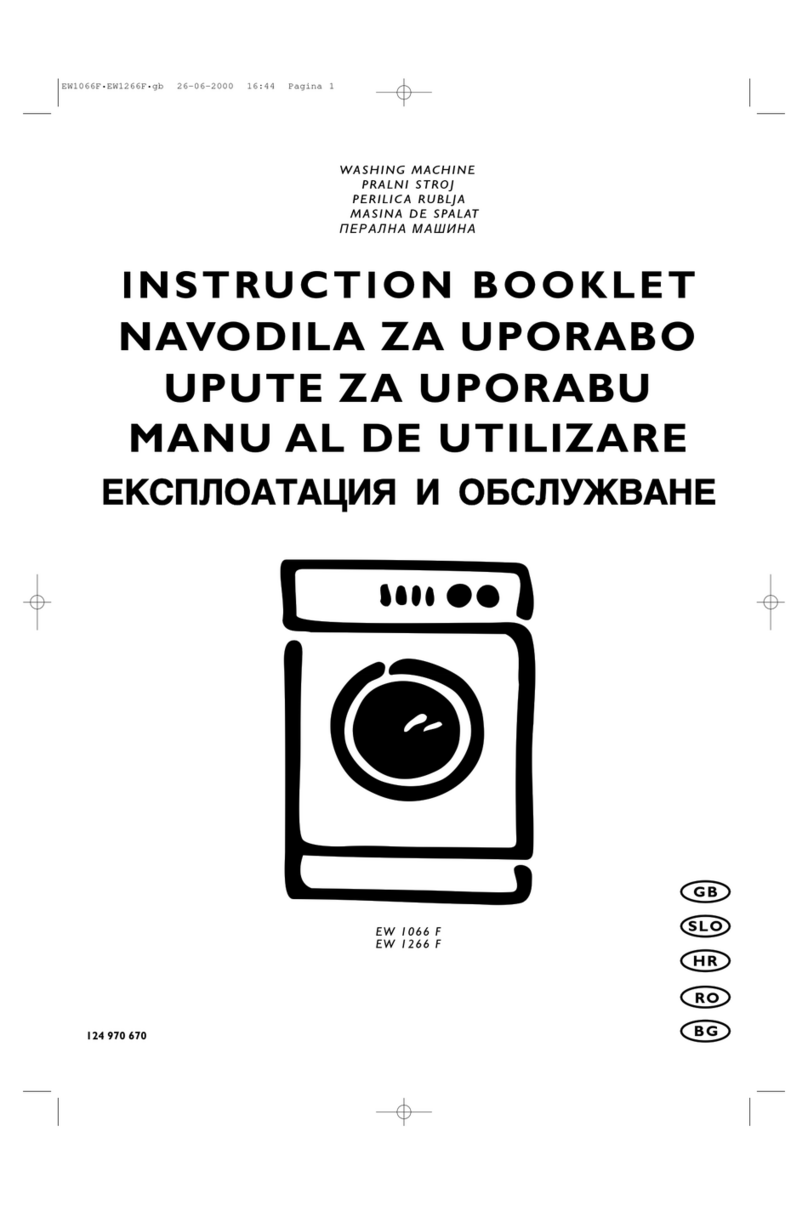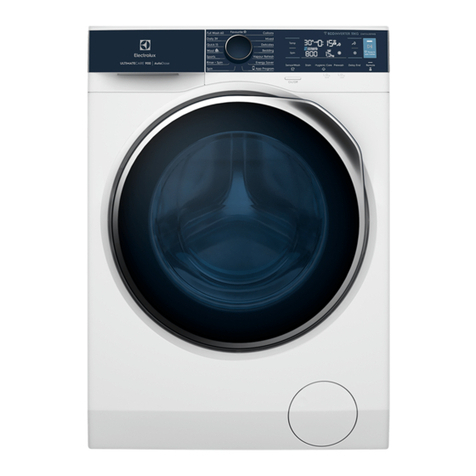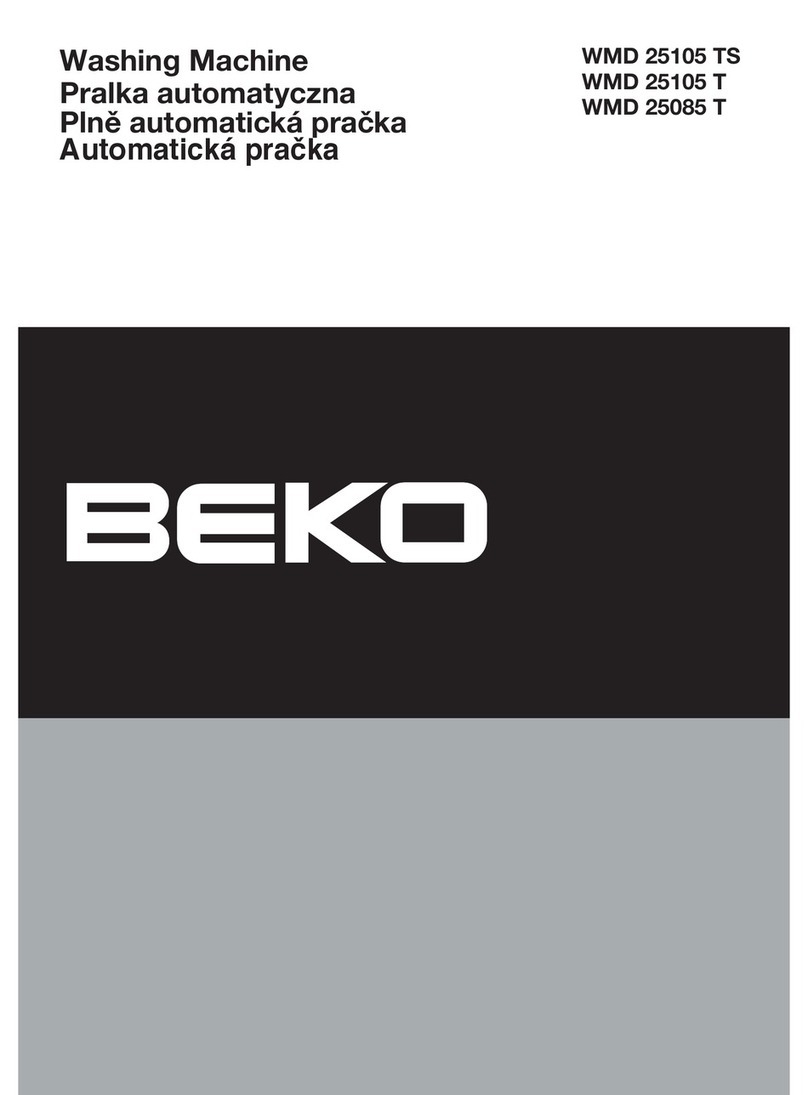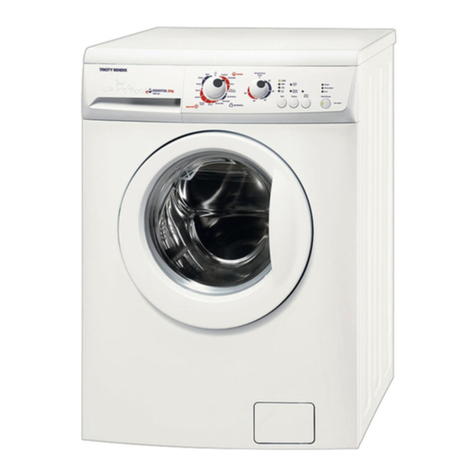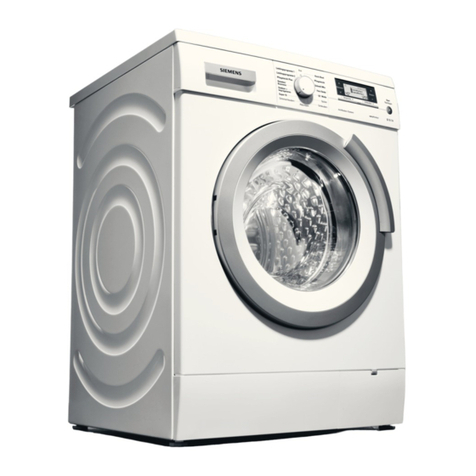Hercules G415 User manual

Herkules Equipment Corporation 2760 Ridgeway Court Walled Lake, MI 48390-1662 USA
248-960-7100 1-800-444-4351 Fax 248-960-7109
Patents USA 4793369, 4960142, 5174317, 5193561, 5485860 Canada 1299468 Made in the USA
website: www.herkules.us e-mail: info@herkules.us
Part# 1002702-03
03-31-08
This manual contains important information
concerning the installation and operation of the gun
washer listed above. Read manual thoroughly
INSTRUCTIONS and keep for future reference.

2
Table of Contents
Warnings ……………………………………………………………………………………….. 3-4
Model Information …………………………………………………………………………….. 5
Installation ....................................................................................................................... 6
Operation ....................................................................................................................... 7-9
Preventive Maintenance ................................................................................................ 10
Troubleshooting .............................................................................................................. 11
Notes ........................................................................................................................... 12-13
Parts layout for G415 ………………………………………………………………………….. 14-16
Warning Symbol Caution Symbol
Serial Number ___________________ Purchase Date _______________
Distributor ___________________ Model Number _______________
CAUTION
WARNING
This symbol alerts you to the possibility of
serious injury or death if you do not follow
the instructions.
This symbol alerts you to the possibility of
damage to or destruction of equipment if
you do not follow the instructions.

3
WARNING
INSTRUCTIONS
EQUIPMENT MISUSE HAZARD
Equipment misuse can cause the equipment to rupture, malfunction, or start unexpectedly
and result in serious injury.
•This equipment is for professional use only.
•Read all instruction manuals, tags, and labels before operating the equipment.
•Use the equipment only for its intended use.
•Do not alter or modify this equipment.
•Do not exceed the maximum working pressure of the lowest rated system component.
•Do not operate the gun washer at a pressure above the maximum working pressure rating of the
gun(s) being cleaned.
•Route the hoses away from traffic areas, sharp edges, moving parts, and hot surfaces.
•Do not use the hoses to pull the equipment.
•Do not move pressurized equipment.
•Use fluids or solvents that are compatible with the equipment wetted parts. Read the fluid and
solvent manufactures warnings.
•Comply with all applicable local, state and national fire, electrical and other safety regulation.
PRESSURIZED EQUIPMENT HAZARD
Spray from hose leaks, ruptured components, or from operating the gun washer with an open
lid can splash fluid in the eyes or on the skin and cause serious injury.
•A safety device has been installed to shut off the pump when the gun washer lid is opened. Do not tamper with
or alter this device.
•Open the gun washer lid slowly.
•Do not prop the gun washer lid open with an object or by any other means.
•Do not stop or deflect fluid leaks with your hand, body, glove, or rag.
•Tighten all fluid connections before operating the equipment.
•Replace worn, damaged, or loose parts immediately.

4
WARNING
FIRE AND EXPLOSION HAZARD
Improper grounding, poor air ventilation, open flames, or sparks can cause a hazardous
condition and result in fire or explosion and serious injury.
•Ground the equipment. See Installation for grounding procedure.
•Provide fresh air ventilation to avoid the build up of flammable fumes from the solvent.
•Extinguish all open flames or pilot lights in gun washer area.
•Electrically disconnect all equipment in the gun washer area.
•Keep the gun washer area free of debris, including solvent, rags, and gasoline.
•Do not turn on any light switch in the gun washer area while operating or if fumes are present.
•Do not smoke in the gun washer area.
•Do not operate a gasoline engine in the gun washer area.
•Follow the gun manufactures solvent and other cleaning recommendations.
•Use solvent with the highest possible flash point.
•If there is any static sparking while using the equipment, stop operation immediately. Identify and correct
the problem.
•Drain the solvent into a proper storage container when gun washer(s) is not in use.
TOXIC FLUID HAZARD
Hazardous fluids or toxic fumes can cause serious injury or death if splashed in eyes or on
the skin, swallowed, or inhaled.
•Know the specific hazards of the fluid you are using. Read the fluid manufactures warnings.
•Store hazardous fluid in an approved container. Dispose of hazardous fluid according to all local, state and
national guidelines.
•Wear the appropriate protective clothing, gloves, eyewear and respirator.
•Pipe and dispose of the exhaust air safely. If diaphragm fails, the fluid may be exhausted along with the air.

5
Model Information
Model Description
Weight
lb. (kg.)
A
B
*C
G415
Equipped with two diaphragm pumps, one for washing and one for
rinsing. Adapted for cleaning pressure pot systems
paint hoses, and cans up to five gallons plus a hand held brush for
manual cleaning of parts. Includes a factory installed Fume
Extractor.
87
(39.5)
42
(1067)
**25.5
(648)
*18
(457)
A
B C
Notes:
* Foot Pedal protrudes an additional 4.5” (114 mm.) past the front of the Gun Washer.
** Must allow room for 5-gallon can of solvent for the clean rinse option on the left side or rear of the Gun Washer.
Dimension in. (mm.)

6
Filter/Regulator
Installation
Installing the Gun Washer
Place gun washer on a level surface in a properly
ventilated paint mixing room.
Connection the Foot Operated Lid Opener
1. Align the hole in the Lid Rod with the hole in the Lid Bracket
and insert the Clevis Pin through the holes (see fig. 1).
2. Place the 1/4” Flat Washer over the Clevis Pin
3. Attach the Circle Cotter Pin to the Clevis Pin (see Fig. 1).
Grounding the Gun Washer
1. Connect the ground wire on the gun washer’s pump
to a true earth ground.
2. Ground all equipment used or located in the gun
washer area.
Connecting the Air Line
1. Install a 1/4 in. npt male coupler, that is compatible
with the quick disconnect of your air supply line, into
the air inlet fitting (see Fig. 2).
2. Connect air line with 90-120 psi to the coupler.
CAUTION
Do not change the setting of the filter/regulator.
this could damage the filter/regulator or pump.
Lid Bracket
Clevis
Circle
Cotter Pin
Lid Rod
Flat
Washer
A
ir Inlet
Fitting
Figure 2
Q.D. Couple
r
Figure 1

7
Operation
Filling the Gun Washer with Fluid
1. Close ball valve located on the bottom of the tank.
2. Pour five gallons (18.9 liters) of high quality, slow
evaporating solvent into the tank.
Preparing the Equipment to be Washed
1. Remove paint cup or paint line and the air line from
the paint gun.
2. Drain excess paint from cup and gun.
3. Remove all gauges and regulators.
4. Lock the gun trigger in the open position by placing
the trigger lock around the gun handle and trigger
(see Fig. 3).
Placing Equipment in the Gun Washer
To clean guns not mentioned here, use the long or short stem
supports as needed (see Fig. 3). For questions or adapter kits
contact your paint gun washer distributor.
Siphon Feed Guns
Place the gun siphon tube on the short stem support.
Gravity Feed Guns (HVLP)
Place the long stem support over the short stem support.
Place paint inlet of gun on long stem support. Place the air
cap assembly over the air inlet of the gun to keep solvent out.
Pressure Feed Guns
Place the long stem support over the short stem support.
Place paint inlet of gun on long stem support.
Pots and Cups
Place pots and/or cups on divider platform over front spray
nozzles.
CAUTION
All pressure gauges must be removed before
placing the equipment in the gun washer to
avoid damaging the gauges.
Figure 3
Trigger Lock
Long Stem Support
Short Stem Support
Air Cap Assembly
Siphon Feed Gun
Paint Cup

8
Operation
Additional Hose and Can Washing Features
Internal Washing of Paint Lines
Remove the brass plugs from the hose wash bulkheads (see
Fig. 4). Install a female fluid quick coupler with 1/4 in. npt male
threads (suitable for lacquer thinner) into the hose wash
bulkheads. Connect the paint line to the couplers. Set the
pointer on the shield to hose clean and operate the gun
washer. Reinstall the brass plugs when resuming normal gun
cleaning operations.
Internal Washing of Paint Lines with Guns Attached
Remove the brass plug from the hose wash bulkhead on the
front of the shield. Install a female fluid quick coupler with 1/4
in. npt male threads (suitable for lacquer thinner). Connect
paint line with gun attached, to the coupler. Set the pointer on
the shield to the hose clean position and operate the gun
washer. To “bleed” the paint (into a container) hold the trigger
of the gun open until thinner begins to flow. Reinstall the brass
plug when resuming normal gun cleaning operations.
Internal and External Washing of Paint Lines with Guns
Attached
Remove the hex plug from the manifold block and Install a
female fluid quick coupler with 1/4 in. npt male threads
(suitable for lacquer thinner) into the center of the manifold
(see Fig. 5). Connect the paint line with gun attached, to the
coupler. Place the paint line with gun attached inside the gun
washer. Lock the gun trigger in the open position with the wire
trigger lock. Set the pointer on the shield to the gun clean
position. Operate the gun washer. Reinstall the hex plug when
resuming normal gun cleaning operations.
Washing Pressure Pot and Lid
Remove the hex plug from the manifold block and insert the
spray nozzle assembly, hanging on the back of the manifold,
into the manifold block (see Fig. 5). Place pot over spray
nozzle. Place the pickup tube of lid over one of the short stem
supports (remove gauges). Operate gun washer. Reinstall the
hex plug when resuming normal gun cleaning operations.
Washing Five Gallon Cans
Remove the hex plug from the manifold block and insert the
spray nozzle assembly, hanging on the back of the manifold,
into the manifold block (see Fig. 5). Place five-gallon can over
spray nozzle. Operate gun washer. Reinstall the hex plug
when resuming normal gun cleaning operations.
Figure 4
Hose Wash
Bulkhead
Hose Wash
Bulkhead
Spray nozzle
assembly
Hex Plug
Manifold Block
Figure 5

9
Operation
Rinsing of Paint Equipment
Place a five-gallon can of clean solvent next to gun washer.
Remove the cap from the can and replace it with the plug
provided in the parts bag. Insert the siphon tube through the
plug, and position the can in the desired location (see Fig. 6).
After the washing cycle is finished, press and hold the rinse
button for approximately 3-6 seconds.
Operating Fume Extractor
Attach a 1-1/4” exhaust hose (not included) to the fume
extractor on the back of the gun washer (see fig. 6). Run the
other end of the hose to the exhaust of the shop paint booth.
DO NOT OPERATE THE GUN WASHER WITHOUT
CONNECTING THE EXHAUST HOSE. The fume extractor will
activate whenever the lid is opened.
Manual Cleaning of Paint Equipment
1. Set the pointer on the shield to the brush clean position.
With the pointer in the brush clean position, the brush will
be activated whenever the lid is opened.
2. To increase the flow through the brush, turn the knob of
the flow control valve counterclockwise. To decrease the
flow through the brush, turn the knob of the flow control
valve clockwise.
Operating the Gun Washer
1. Make sure all wire trigger locks and other accessories are
inside the gun washer tank.
2. If washing only one set of equipment, place empty cans
over the unused nozzles and/or stem supports to prevent
solvent spray from hitting the underside of the gun washer
lid.
3. Close the gun washer lid.
4. Set the pointer to Gun Clean.
5. Turn the timer knob clockwise 90 degrees to the ON
position to start the gun washer. The gun washer will run for
90 seconds. Turning the timer knob less than 90 degrees
will reduce the timing cycle. Paint equipment will clean in 60
to 90 seconds.
6. If the lid is opened prior to the end of the timing cycle, the
safety air cutoff switch will stop the gun washer. The gun
washer will start again when the lid is closed if time
remains on the timer.
Note: Open and close the lid slowly to minimize solvent
vapor escape.
7. Remove the equipment from the gun washer and wipe off
any remaining solvent. The gun hanger on the front of the
stand can be used to dry the guns.
Manual Clean
Brush
Flow
Control
Valve
Figure 6
Rinse Button
Siphon Tube
Plug
Fume Extractor
Exhaust Hose
Figure 7

10
Preventive Maintenance
1. Drain excess paint from cup or pot before placing in gun washer.
2. Drain paint sludge from gun washer tank weekly. Do this after a weekend so that it has settled. Open ball valve and drain until clear
solvent flows. Add solvent to 1” above intake filter.
4. Remove the filter bowl and check the filter inside the regulator for excess buildup approx. every 6 months
5. Change solvent completely when objects being cleaned become tacky to the touch.
6. Clean inside of tub and intake filter assembly #12491 before filling with solvent.
CAUTION
Do not change the setting of the filter/regulator.
This could damage the filter/regulator or pump.
Figure 8
Filter/Regulator
#T17M
Filte
r
#1001382
Filter Bowl

11
Troubleshooting
Problem Possible Solution
Gun washer will not turn on.
1. Make sure the air line is properly connected with 90-120 psi.
2. Make sure lid is fully closed. Make sure the limit valve
on the pump bracket is closed in the downward position.
3. Check all air connections to ensure that there are no leaks.
4. Make sure timer cam is engaging the limit valve (#M1C) on the
shield assembly.
5. Make sure timer is on and functioning correctly.
Gun washer turns on but
pumps slowly or not at all.
1. Make sure intake filter (#12491) is not clogged (Clean or replace).
2. Make sure the air line is properly connected with 90-120 psi.
3. Check all air connections to ensure that there are no leaks.
4. Drain filter/regulator of water. See number 3 of PREVENTIVE
MAINTENANCE.
5. Make sure there are 5 gallons of clean solvent in the gun washer.
The solvent should be an inch above the intake filter (#12491).
6. Make sure lid is fully closed. Make sure the limit valve on
the pump bracket is closed in the downward position.
7. Make sure manifold nozzles and stem supports are not clogged.
Gun washer will not shut off.
1. Make sure timer cam (#M230-001A) is moving. If its not, slightly
loosen the nuts holding the limit valve (#M1C) on the shield.
Reposition valve and tighten nuts.
Rinse cycle will not work.
1. Check the level of the rinse solvent.
2. Check all fluid connections to ensure that there are no leaks.
Manual Brush will not work
1. Clean or replace the brush filter (see fig. 7).
2. Check Orifice plate for obstructions (see fig. 7).

12
Notes

13
Notes

14
Parts Layout for G415
Manual Brush
#1000563
Flex Tube
#100-079
Flow Control Valve
#1003172
Lid Rod
#1002573
A
ctuato
r
#28
Foot Pedal
#1001099
Pump Assembly
#12598
Ball Valve
#6
Filter Assembly
#12491
Lid Assembly
#10444
Manifold Tube
#12494 Manifold Assembly
#12593
Lid Stop
#11051
Tank Assembly
#10099
Pump Bracket
#10638
Brace Center
#10925
Screw #10 x 5/8 SS
#1000663
Divide
r
#1000540
Front Brace
#10923
Brace Upper
#10639
Brace Back
#10924
Shield Assembly
#12597
Lid Sticke
r
#1001709
Panel Assembly
#10637
Panel Front
#1001002
Fume Extractor
#1000948
Elbow
#002-131
Hose Barb
#990
Guard
#11049

15
Shield Assembly
#12597
Timer Knob
#M230-002
Socket Screw
#002-171
Spacer
#M230-004
Filter/Regulator
#T17M
Time
r
#M230-001
A
Tube Fitting
#T4
Limit Valve
#M1C
Timer Cam
#M230-003
Hex Head Scre
w
#005-119
Space
r
#M230-005
Removable Cap
#1000903
Or Valve
#1000851
Hose Barb
#990
Actuato
r
#1000907
Mounting Bracket
#11217 Limit Valve
#M1C
Tube Fitting
#T25
Reducing Coupler
#C7
Tube Fitting
#T4
3-Way Valve
#C26
Connector
#1000218
Hose Barb
#1000967
Panel
#1001000
Note:
The following tubing is not shown.
5/32” blue nylon tubing #M5
5/32” black nylon tubing #M5-BLACK
5/32” clear nylon tubing #M5-
NEUTRAL
1/2” OD black polyethylene #64PE
3/8” OD black polyethylene #M7APE
Limit Valve
#1000905
Support Bracket
#13149
A
dapto
r
#67

16
Shield Assembly
#10637
Manifold Assembly
#12596
Limit Valve
#M2
Tube Fitting
#T3
5/32”Nylon Tubing
#M5
Tube Fitting
#T4
Reducing Couple
r
#C7
Connector
Elbow
#
1002921
Flat Washer
#85D
1/2” Polyethylene Tubing
#64PE
Elbow
#C4B
Hose Barb
#57
Street Elbo
w
#002-131
Diaphragm Pump
#318
3/8” Polyethylene Tubing
#M7APE
Panel
#1001001
Stem Support
#53
A
Jet Nozzle
#54P1
Manifold Bolt
#002-136S
Connector
#002-143
Street Tee
#C12D
Check Ball
A
ssy.
#005-145
Tube Fitting
#T24
Acorn Nut
#008-244
Hose Barb
#1000981
3/8” ID Blue Hose
#100-084
Table of contents
Other Hercules Washer manuals
